Understanding first year university students’ passivity via their attitudes and language behaviors towards answering questions in class
Learning styles and learning strategies play a key role in learners’ success and autonomy in language learning. However, the majority of research in this area is carried out in foreign context rather than locally. Thus, many false assumptions have been made about Asian learning styles in general and Vietnamese learners in particular, i.e. they are passive and group-Oriented learners, and they tend to learn by rote and memorize knowledge. In an attempt to find out if Vietnamese first year university non-English majored learners are passive or active, the study investigates their attitudes and language behaviors towards answering questions in class. The major findings from valid questionnaires responded by 90 students from five different technology-grouped departments reveal that Vietnamese students are not passive at all and the reasons why they appear passive are related to their shyness and face-saving attitudes. No statistically significant association was found between students’ personality and their passivity in the classroom
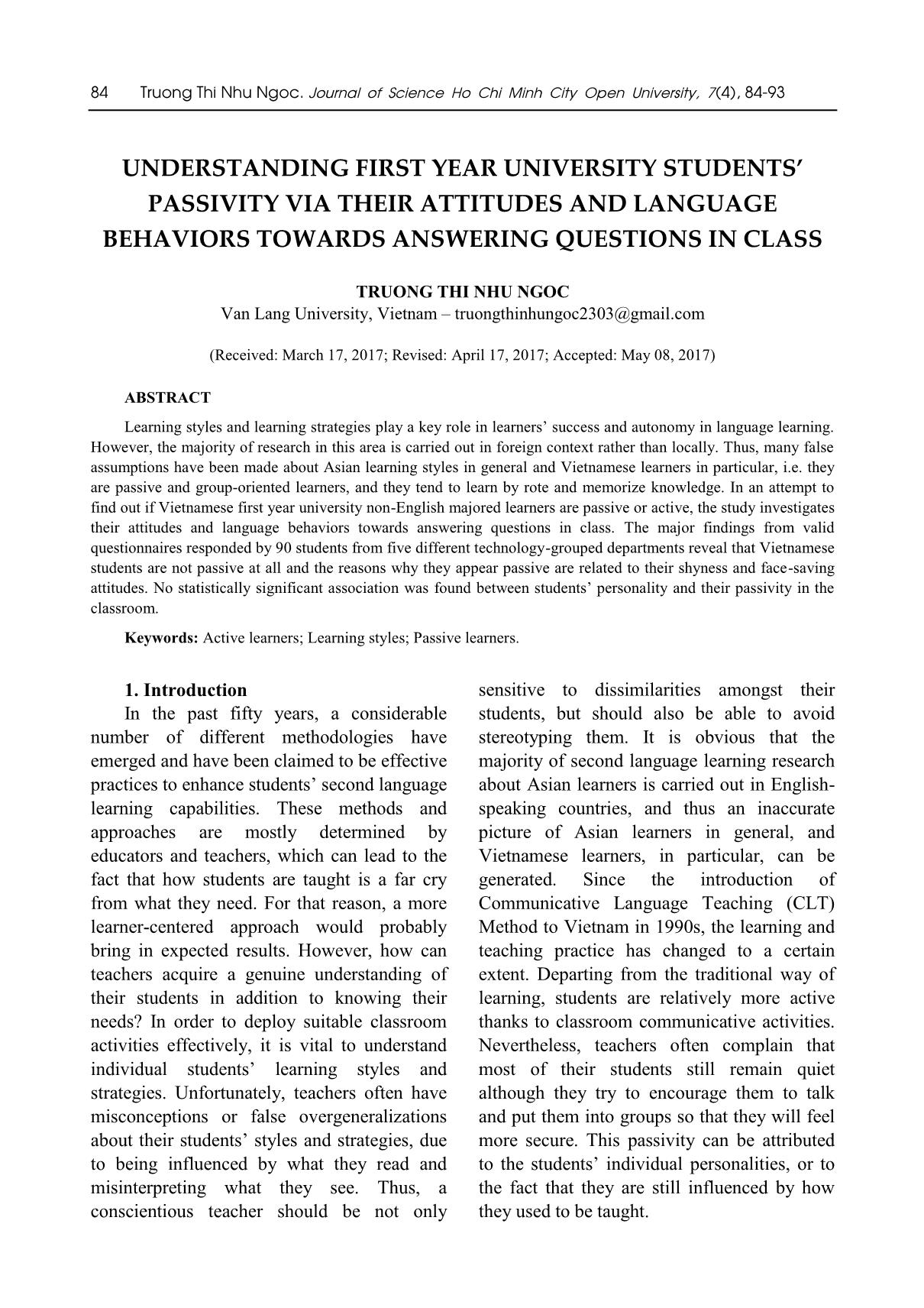
Trang 1
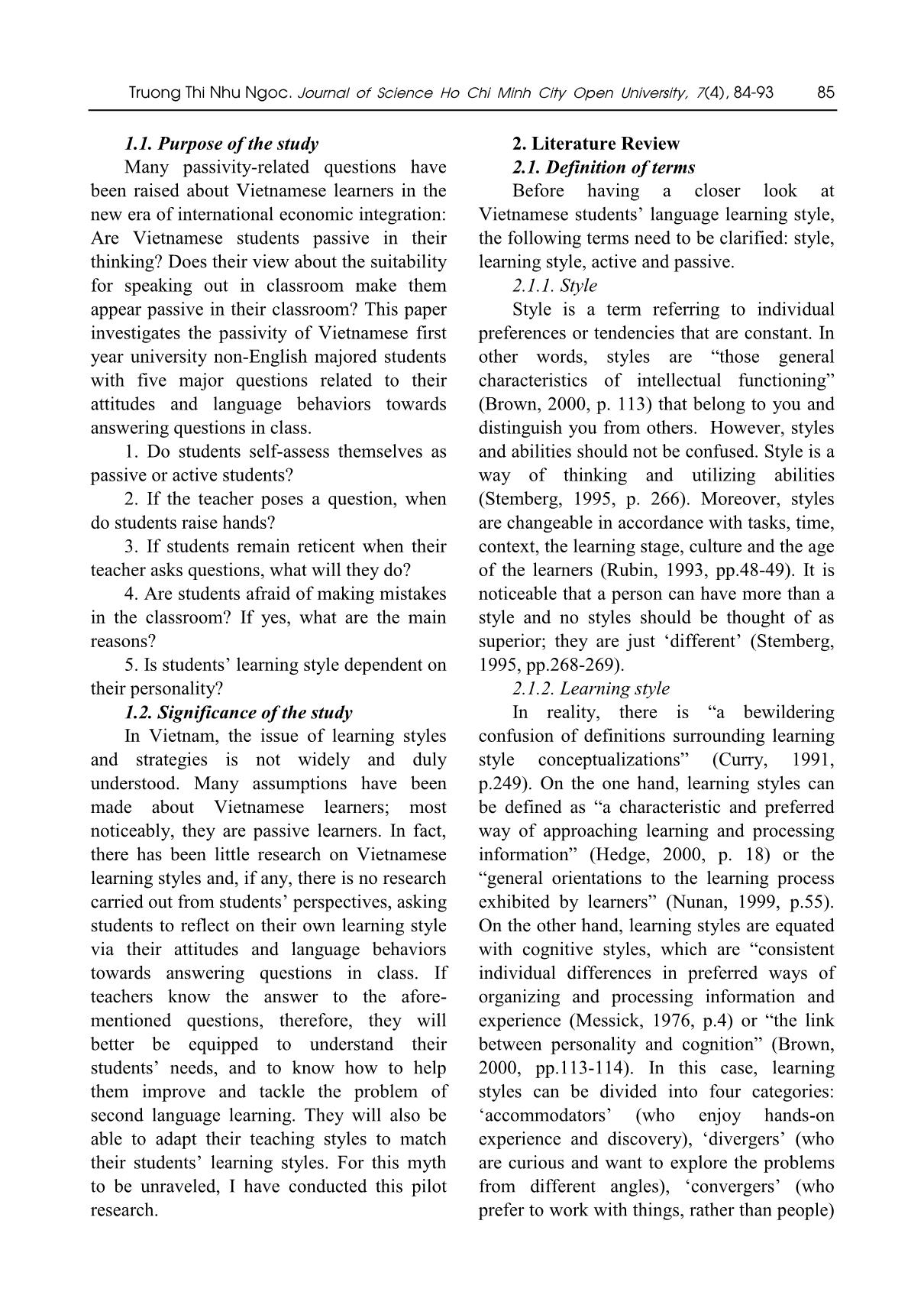
Trang 2
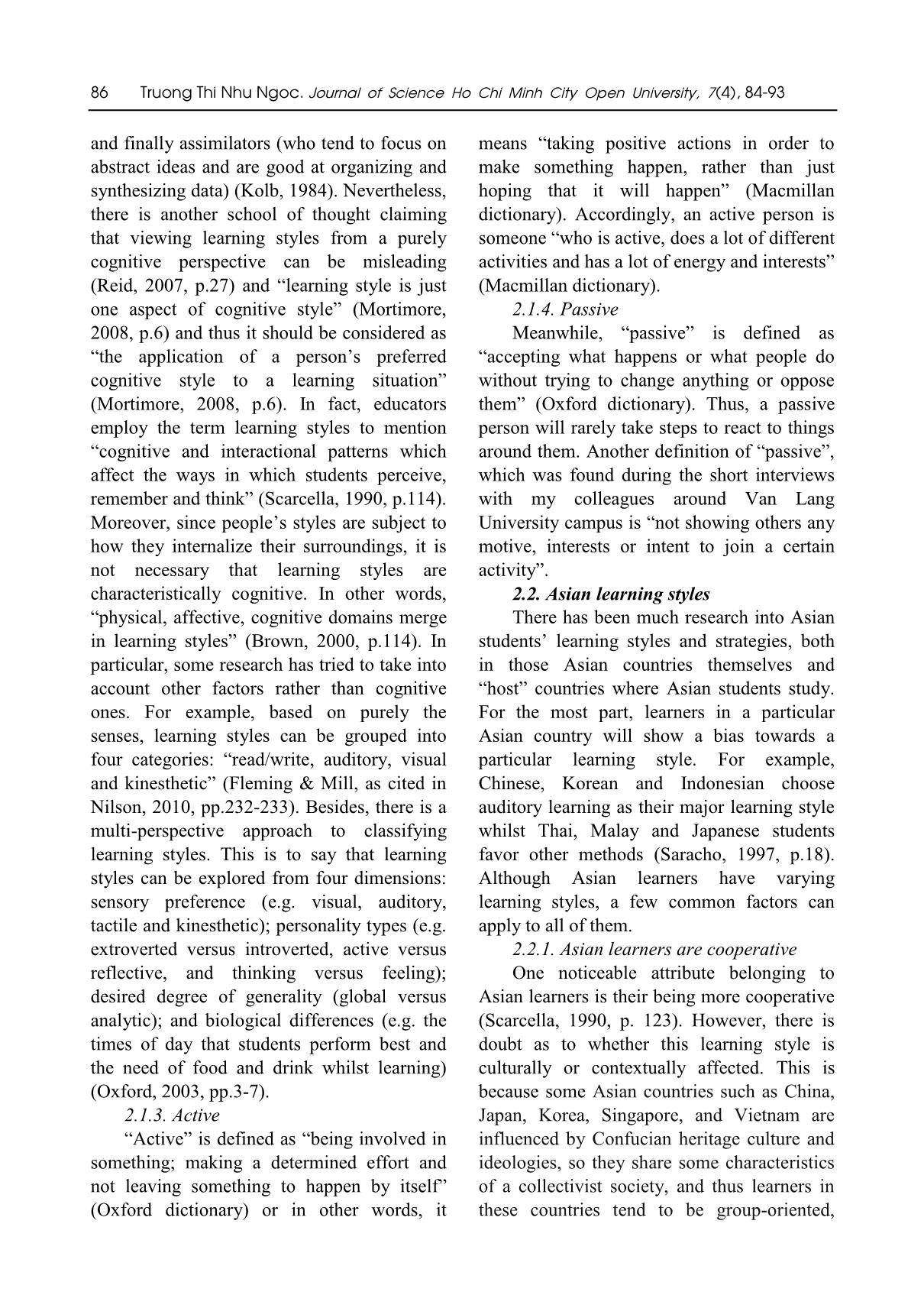
Trang 3
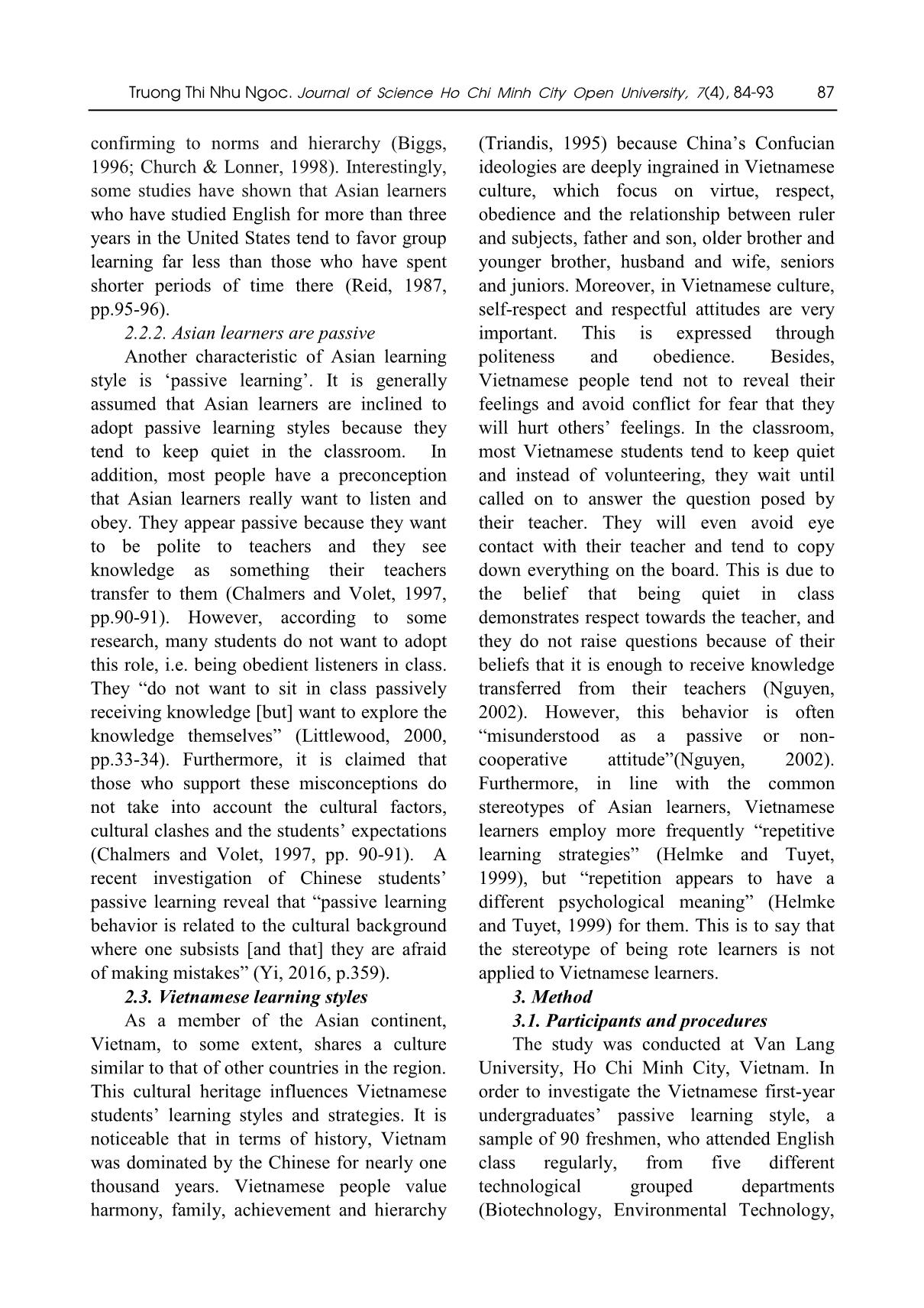
Trang 4
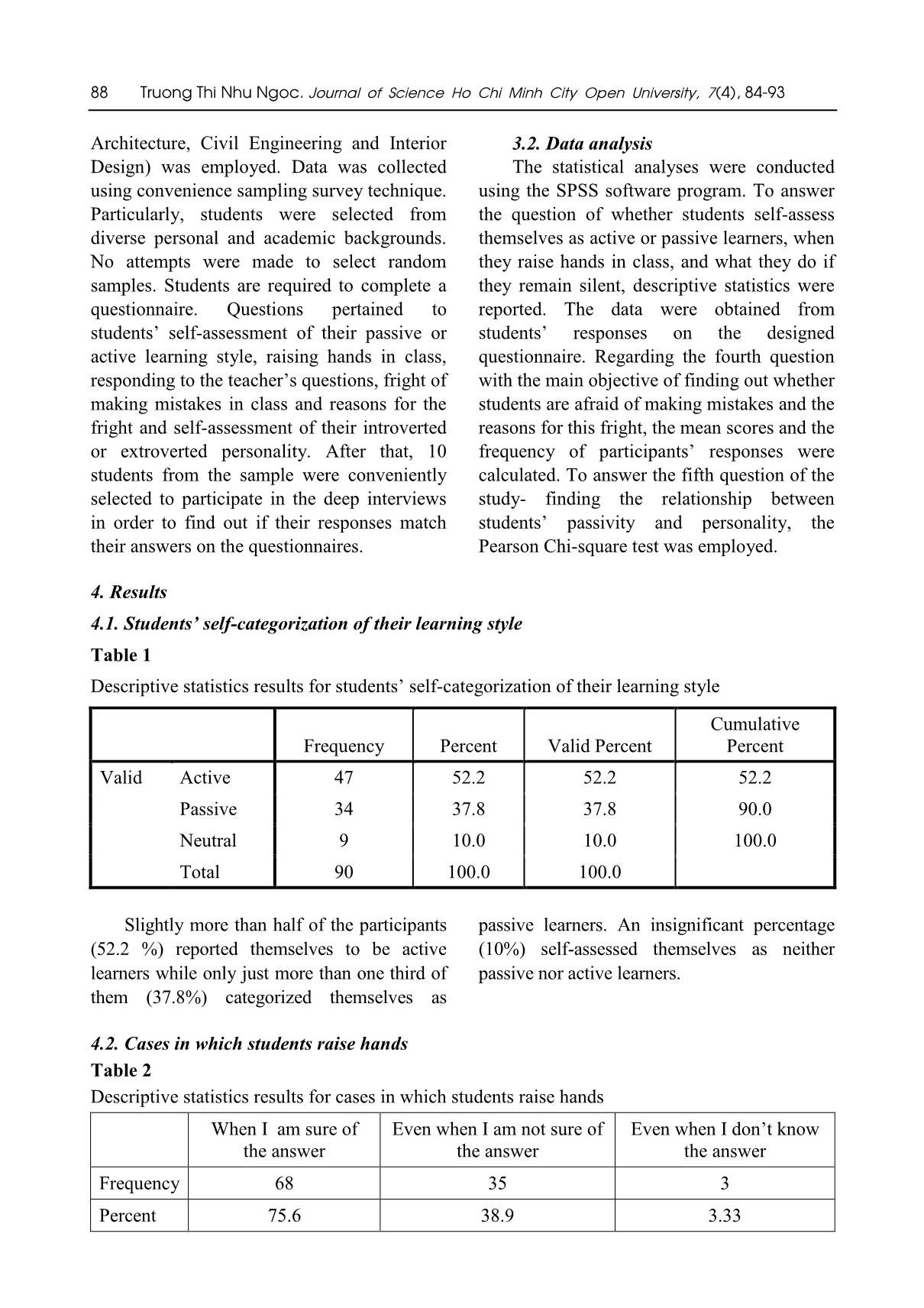
Trang 5
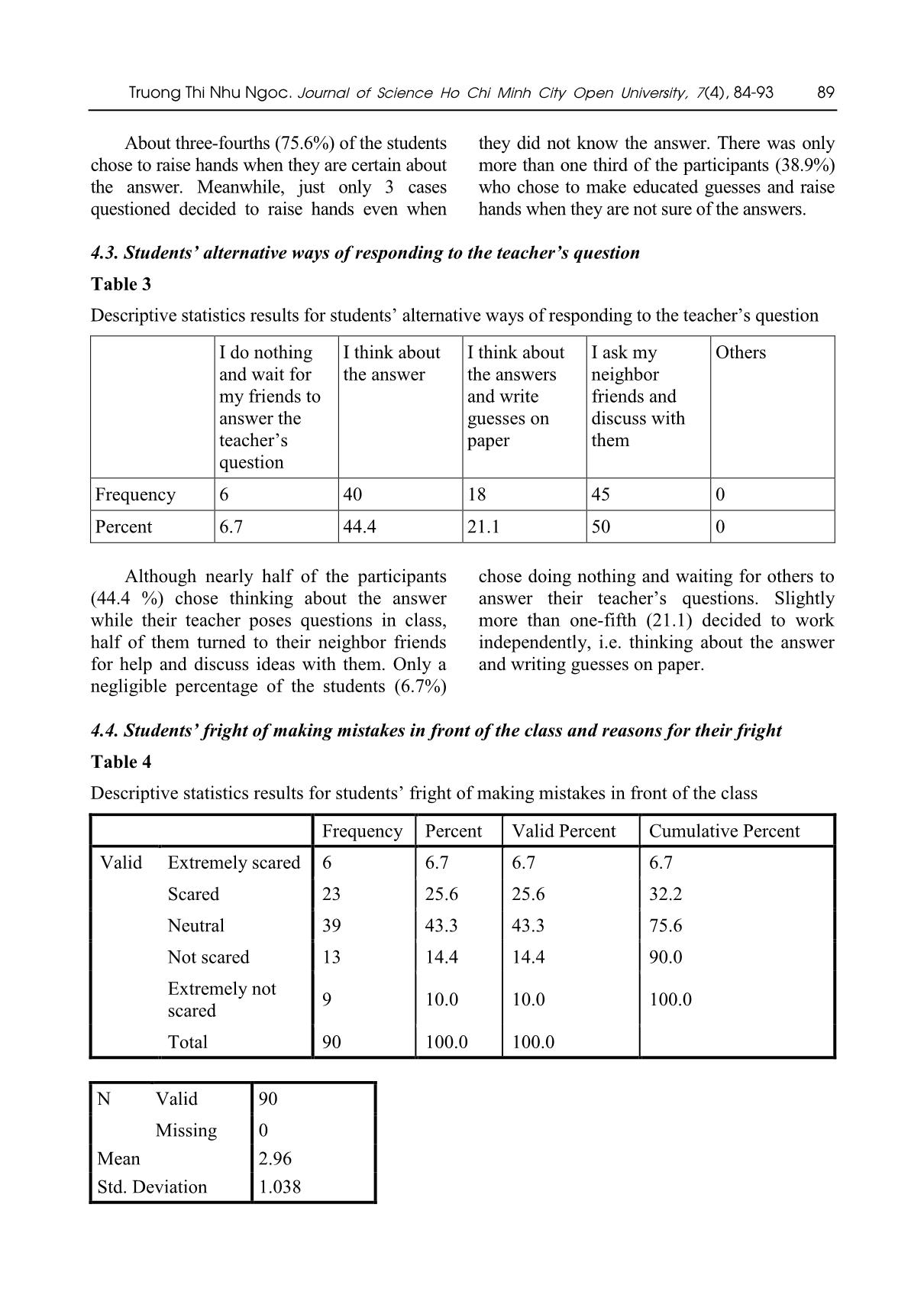
Trang 6
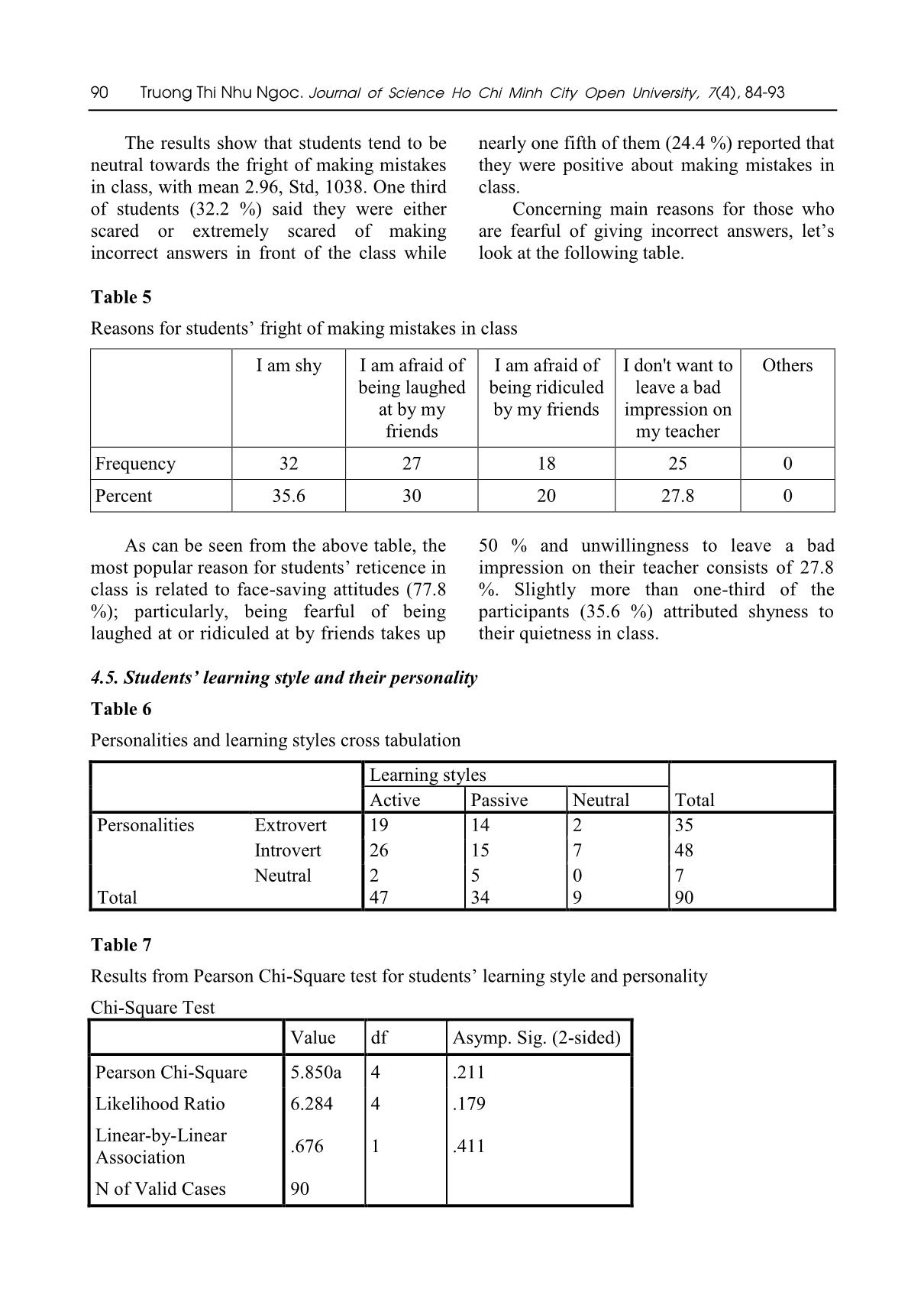
Trang 7
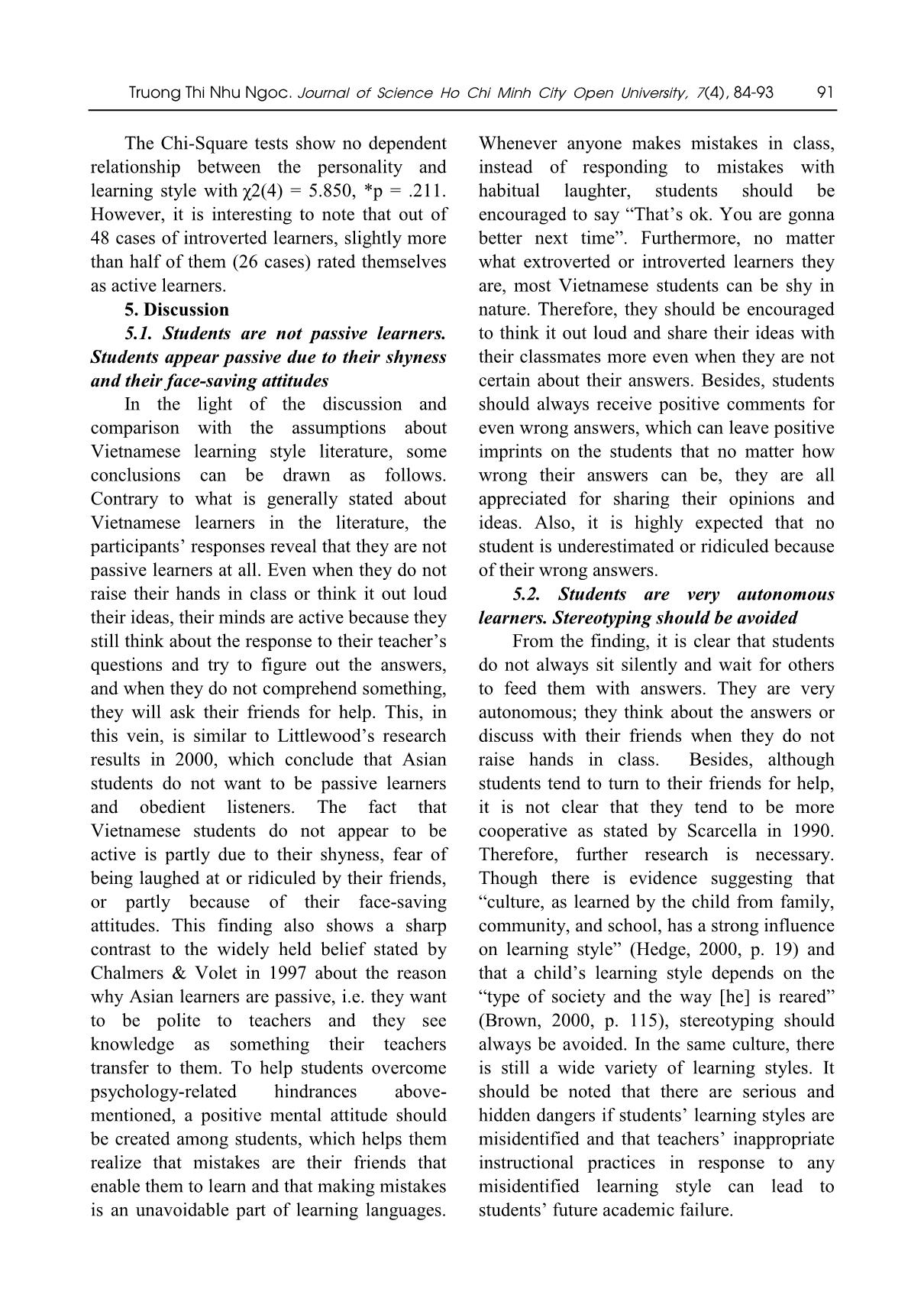
Trang 8
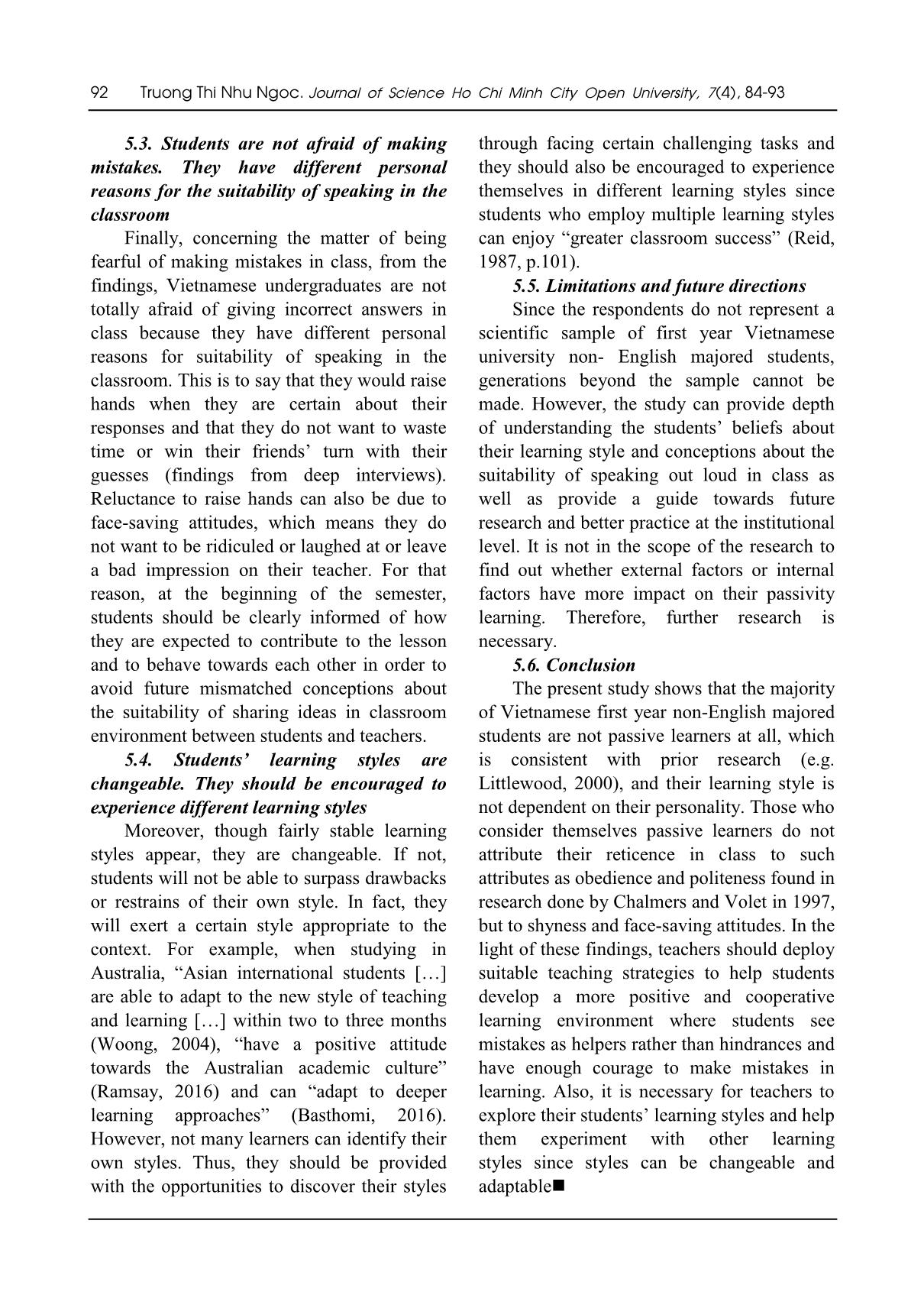
Trang 9
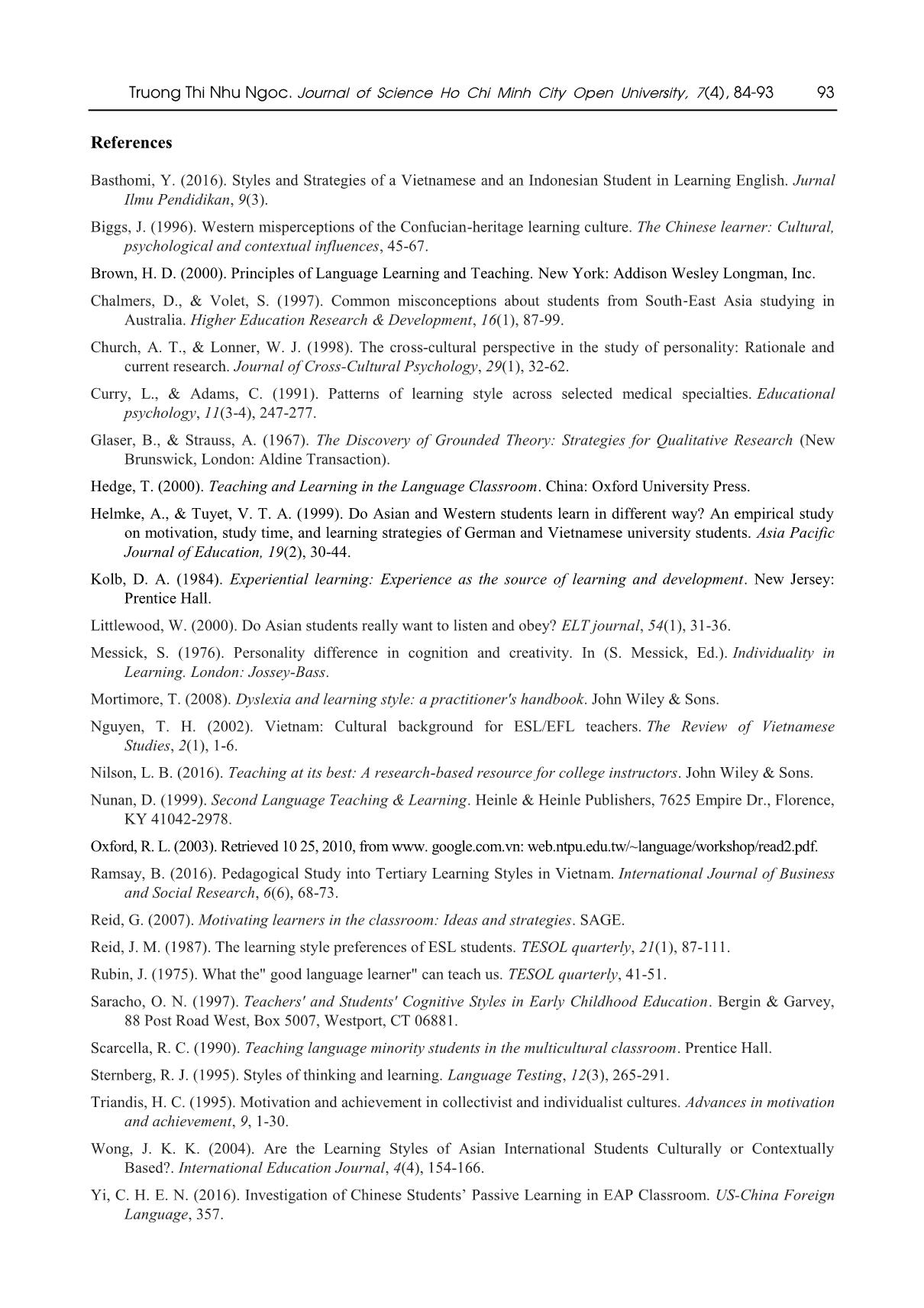
Trang 10
Tóm tắt nội dung tài liệu: Understanding first year university students’ passivity via their attitudes and language behaviors towards answering questions in class
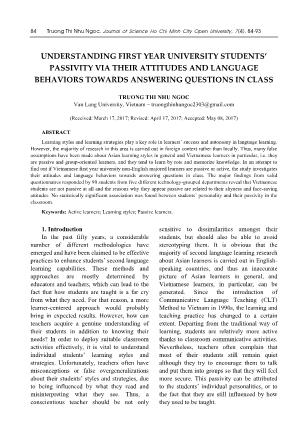
84 Truong Thi Nhu Ngoc. Journal of Science Ho Chi Minh City Open University, 7(4), 84-93 UNDERSTANDING FIRST YEAR UNIVERSITY STUDENTS’ PASSIVITY VIA THEIR ATTITUDES AND LANGUAGE BEHAVIORS TOWARDS ANSWERING QUESTIONS IN CLASS TRUONG THI NHU NGOC Van Lang University, Vietnam – truongthinhungoc2303@gmail.com (Received: March 17, 2017; Revised: April 17, 2017; Accepted: May 08, 2017) ABSTRACT Learning styles and learning strategies play a key role in learners’ success and autonomy in language learning. However, the majority of research in this area is carried out in foreign context rather than locally. Thus, many false assumptions have been made about Asian learning styles in general and Vietnamese learners in particular, i.e. they are passive and group-oriented learners, and they tend to learn by rote and memorize knowledge. In an attempt to find out if Vietnamese first year university non-English majored learners are passive or active, the study investigates their attitudes and language behaviors towards answering questions in class. The major findings from valid questionnaires responded by 90 students from five different technology-grouped departments reveal that Vietnamese students are not passive at all and the reasons why they appear passive are related to their shyness and face-saving attitudes. No statistically significant association was found between students’ personality and their passivity in the classroom. Keywords: Active learners; Learning styles; Passive learners. 1. Introduction In the past fifty years, a considerable number of different methodologies have emerged and have been claimed to be effective practices to enhance students’ second language learning capabilities. These methods and approaches are mostly determined by educators and teachers, which can lead to the fact that how students are taught is a far cry from what they need. For that reason, a more learner-centered approach would probably bring in expected results. However, how can teachers acquire a genuine understanding of their students in addition to knowing their needs? In order to deploy suitable classroom activities effectively, it is vital to understand individual students’ learning styles and strategies. Unfortunately, teachers often have misconceptions or false overgeneralizations about their students’ styles and strategies, due to being influenced by what they read and misinterpreting what they see. Thus, a conscientious teacher should be not only sensitive to dissimilarities amongst their students, but should also be able to avoid stereotyping them. It is obvious that the majority of second language learning research about Asian learners is carried out in English- speaking countries, and thus an inaccurate picture of Asian learners in general, and Vietnamese learners, in particular, can be generated. Since the introduction of Communicative Language Teaching (CLT) Method to Vietnam in 1990s, the learning and teaching practice has changed to a certain extent. Departing from the traditional way of learning, students are relatively more active thanks to classroom communicative activities. Nevertheless, teachers often complain that most of their students still remain quiet although they try to encourage them to talk and put them into groups so that they will feel more secure. This passivity can be attributed to the students’ individual personalities, or to the fact that they are still influenced by how they used to be taught. Truong Thi Nhu Ngoc. Journal of Science Ho Chi Minh City Open University, 7(4), 84-93 85 1.1. Purpose of the study Many passivity-related questions have been raised about Vietnamese learners in the new era of international economic integration: Are Vietnamese students passive in their thinking? Does their view about the suitability for speaking out in classroom make them appear passive in their classroom? This paper investigates the passivity of Vietnamese first year university non-English majored students with five major questions related to their attitudes and language behaviors towards answering questions in class. 1. Do students self-assess themselves as passive or active students? 2. If the teacher poses a question, when do students raise hands? 3. If students remain reticent when their teacher asks questions, what will they do? 4. Are students afraid of making mistakes in the classroom? If yes, what are the main reasons? 5. Is students’ learning style dependent on their personality? 1.2. Significance of the study In Vietnam, the issue of learning styles and strategies is not widely and duly understood. Many assumptions have been made about Vietnamese learners; most noticeably, they are passive learners. In fact, there has been little research on Vietnamese learning styles and, if any, there is no research carried out from students’ perspectives, asking students to reflect on their own learning style via their attitudes and language behaviors towards answering questions in class. If teachers know the answer to the afore- mentioned questions, therefore, they will better be equipped to understand their students’ needs, and to know how to help them improve and tackle the problem of second language learning. They will also be able to adapt their teaching styles to match their students’ learning styles. For this myth to be unraveled, I have conducted this pilot research. 2. Literature Review 2.1. Definition of terms Before having a closer look at Vietnamese students’ language learning style, the following terms need to be clarified: style, learning style, active and passive. 2.1.1. Style Style is a term referring to individual preferences or tendencies that are constant. In other words, styles are “those general characteristics of intellectual func ... .4 90.0 Extremely not scared 9 10.0 10.0 100.0 Total 90 100.0 100.0 N Valid 90 Missing 0 Mean 2.96 Std. Deviation 1.038 90 Truong Thi Nhu Ngoc. Journal of Science Ho Chi Minh City Open University, 7(4), 84-93 The results show that students tend to be neutral towards the fright of making mistakes in class, with mean 2.96, Std, 1038. One third of students (32.2 %) said they were either scared or extremely scared of making incorrect answers in front of the class while nearly one fifth of them (24.4 %) reported that they were positive about making mistakes in class. Concerning main reasons for those who are fearful of giving incorrect answers, let’s look at the following table. Table 5 Reasons for students’ fright of making mistakes in class I am shy I am afraid of being laughed at by my friends I am afraid of being ridiculed by my friends I don't want to leave a bad impression on my teacher Others Frequency 32 27 18 25 0 Percent 35.6 30 20 27.8 0 As can be seen from the above table, the most popular reason for students’ reticence in class is related to face-saving attitudes (77.8 %); particularly, being fearful of being laughed at or ridiculed at by friends takes up 50 % and unwillingness to leave a bad impression on their teacher consists of 27.8 %. Slightly more than one-third of the participants (35.6 %) attributed shyness to their quietness in class. 4.5. Students’ learning style and their personality Table 6 Personalities and learning styles cross tabulation Learning styles Total Active Passive Neutral Personalities Extrovert 19 14 2 35 Introvert 26 15 7 48 Neutral 2 5 0 7 Total 47 34 9 90 Table 7 Results from Pearson Chi-Square test for students’ learning style and personality Chi-Square Test Value df Asymp. Sig. (2-sided) Pearson Chi-Square 5.850a 4 .211 Likelihood Ratio 6.284 4 .179 Linear-by-Linear Association .676 1 .411 N of Valid Cases 90 Truong Thi Nhu Ngoc. Journal of Science Ho Chi Minh City Open University, 7(4), 84-93 91 The Chi-Square tests show no dependent relationship between the personality and learning style with χ2(4) = 5.850, *p = .211. However, it is interesting to note that out of 48 cases of introverted learners, slightly more than half of them (26 cases) rated themselves as active learners. 5. Discussion 5.1. Students are not passive learners. Students appear passive due to their shyness and their face-saving attitudes In the light of the discussion and comparison with the assumptions about Vietnamese learning style literature, some conclusions can be drawn as follows. Contrary to what is generally stated about Vietnamese learners in the literature, the participants’ responses reveal that they are not passive learners at all. Even when they do not raise their hands in class or think it out loud their ideas, their minds are active because they still think about the response to their teacher’s questions and try to figure out the answers, and when they do not comprehend something, they will ask their friends for help. This, in this vein, is similar to Littlewood’s research results in 2000, which conclude that Asian students do not want to be passive learners and obedient listeners. The fact that Vietnamese students do not appear to be active is partly due to their shyness, fear of being laughed at or ridiculed by their friends, or partly because of their face-saving attitudes. This finding also shows a sharp contrast to the widely held belief stated by Chalmers & Volet in 1997 about the reason why Asian learners are passive, i.e. they want to be polite to teachers and they see knowledge as something their teachers transfer to them. To help students overcome psychology-related hindrances above- mentioned, a positive mental attitude should be created among students, which helps them realize that mistakes are their friends that enable them to learn and that making mistakes is an unavoidable part of learning languages. Whenever anyone makes mistakes in class, instead of responding to mistakes with habitual laughter, students should be encouraged to say “That’s ok. You are gonna better next time”. Furthermore, no matter what extroverted or introverted learners they are, most Vietnamese students can be shy in nature. Therefore, they should be encouraged to think it out loud and share their ideas with their classmates more even when they are not certain about their answers. Besides, students should always receive positive comments for even wrong answers, which can leave positive imprints on the students that no matter how wrong their answers can be, they are all appreciated for sharing their opinions and ideas. Also, it is highly expected that no student is underestimated or ridiculed because of their wrong answers. 5.2. Students are very autonomous learners. Stereotyping should be avoided From the finding, it is clear that students do not always sit silently and wait for others to feed them with answers. They are very autonomous; they think about the answers or discuss with their friends when they do not raise hands in class. Besides, although students tend to turn to their friends for help, it is not clear that they tend to be more cooperative as stated by Scarcella in 1990. Therefore, further research is necessary. Though there is evidence suggesting that “culture, as learned by the child from family, community, and school, has a strong influence on learning style” (Hedge, 2000, p. 19) and that a child’s learning style depends on the “type of society and the way [he] is reared” (Brown, 2000, p. 115), stereotyping should always be avoided. In the same culture, there is still a wide variety of learning styles. It should be noted that there are serious and hidden dangers if students’ learning styles are misidentified and that teachers’ inappropriate instructional practices in response to any misidentified learning style can lead to students’ future academic failure. 92 Truong Thi Nhu Ngoc. Journal of Science Ho Chi Minh City Open University, 7(4), 84-93 5.3. Students are not afraid of making mistakes. They have different personal reasons for the suitability of speaking in the classroom Finally, concerning the matter of being fearful of making mistakes in class, from the findings, Vietnamese undergraduates are not totally afraid of giving incorrect answers in class because they have different personal reasons for suitability of speaking in the classroom. This is to say that they would raise hands when they are certain about their responses and that they do not want to waste time or win their friends’ turn with their guesses (findings from deep interviews). Reluctance to raise hands can also be due to face-saving attitudes, which means they do not want to be ridiculed or laughed at or leave a bad impression on their teacher. For that reason, at the beginning of the semester, students should be clearly informed of how they are expected to contribute to the lesson and to behave towards each other in order to avoid future mismatched conceptions about the suitability of sharing ideas in classroom environment between students and teachers. 5.4. Students’ learning styles are changeable. They should be encouraged to experience different learning styles Moreover, though fairly stable learning styles appear, they are changeable. If not, students will not be able to surpass drawbacks or restrains of their own style. In fact, they will exert a certain style appropriate to the context. For example, when studying in Australia, “Asian international students [] are able to adapt to the new style of teaching and learning [] within two to three months (Woong, 2004), “have a positive attitude towards the Australian academic culture” (Ramsay, 2016) and can “adapt to deeper learning approaches” (Basthomi, 2016). However, not many learners can identify their own styles. Thus, they should be provided with the opportunities to discover their styles through facing certain challenging tasks and they should also be encouraged to experience themselves in different learning styles since students who employ multiple learning styles can enjoy “greater classroom success” (Reid, 1987, p.101). 5.5. Limitations and future directions Since the respondents do not represent a scientific sample of first year Vietnamese university non- English majored students, generations beyond the sample cannot be made. However, the study can provide depth of understanding the students’ beliefs about their learning style and conceptions about the suitability of speaking out loud in class as well as provide a guide towards future research and better practice at the institutional level. It is not in the scope of the research to find out whether external factors or internal factors have more impact on their passivity learning. Therefore, further research is necessary. 5.6. Conclusion The present study shows that the majority of Vietnamese first year non-English majored students are not passive learners at all, which is consistent with prior research (e.g. Littlewood, 2000), and their learning style is not dependent on their personality. Those who consider themselves passive learners do not attribute their reticence in class to such attributes as obedience and politeness found in research done by Chalmers and Volet in 1997, but to shyness and face-saving attitudes. In the light of these findings, teachers should deploy suitable teaching strategies to help students develop a more positive and cooperative learning environment where students see mistakes as helpers rather than hindrances and have enough courage to make mistakes in learning. Also, it is necessary for teachers to explore their students’ learning styles and help them experiment with other learning styles since styles can be changeable and adaptable Truong Thi Nhu Ngoc. Journal of Science Ho Chi Minh City Open University, 7(4), 84-93 93 References Basthomi, Y. (2016). Styles and Strategies of a Vietnamese and an Indonesian Student in Learning English. Jurnal Ilmu Pendidikan, 9(3). Biggs, J. (1996). Western misperceptions of the Confucian-heritage learning culture. The Chinese learner: Cultural, psychological and contextual influences, 45-67. Brown, H. D. (2000). Principles of Language Learning and Teaching. New York: Addison Wesley Longman, Inc. Chalmers, D., & Volet, S. (1997). Common misconceptions about students from South‐East Asia studying in Australia. Higher Education Research & Development, 16(1), 87-99. Church, A. T., & Lonner, W. J. (1998). The cross-cultural perspective in the study of personality: Rationale and current research. Journal of Cross-Cultural Psychology, 29(1), 32-62. Curry, L., & Adams, C. (1991). Patterns of learning style across selected medical specialties. Educational psychology, 11(3-4), 247-277. Glaser, B., & Strauss, A. (1967). The Discovery of Grounded Theory: Strategies for Qualitative Research (New Brunswick, London: Aldine Transaction). Hedge, T. (2000). Teaching and Learning in the Language Classroom. China: Oxford University Press. Helmke, A., & Tuyet, V. T. A. (1999). Do Asian and Western students learn in different way? An empirical study on motivation, study time, and learning strategies of German and Vietnamese university students. Asia Pacific Journal of Education, 19(2), 30-44. Kolb, D. A. (1984). Experiential learning: Experience as the source of learning and development. New Jersey: Prentice Hall. Littlewood, W. (2000). Do Asian students really want to listen and obey? ELT journal, 54(1), 31-36. Messick, S. (1976). Personality difference in cognition and creativity. In (S. Messick, Ed.). Individuality in Learning. London: Jossey-Bass. Mortimore, T. (2008). Dyslexia and learning style: a practitioner's handbook. John Wiley & Sons. Nguyen, T. H. (2002). Vietnam: Cultural background for ESL/EFL teachers. The Review of Vietnamese Studies, 2(1), 1-6. Nilson, L. B. (2016). Teaching at its best: A research-based resource for college instructors. John Wiley & Sons. Nunan, D. (1999). Second Language Teaching & Learning. Heinle & Heinle Publishers, 7625 Empire Dr., Florence, KY 41042-2978. Oxford, R. L. (2003). Retrieved 10 25, 2010, from www. google.com.vn: web.ntpu.edu.tw/~language/workshop/read2.pdf. Ramsay, B. (2016). Pedagogical Study into Tertiary Learning Styles in Vietnam. International Journal of Business and Social Research, 6(6), 68-73. Reid, G. (2007). Motivating learners in the classroom: Ideas and strategies. SAGE. Reid, J. M. (1987). The learning style preferences of ESL students. TESOL quarterly, 21(1), 87-111. Rubin, J. (1975). What the" good language learner" can teach us. TESOL quarterly, 41-51. Saracho, O. N. (1997). Teachers' and Students' Cognitive Styles in Early Childhood Education. Bergin & Garvey, 88 Post Road West, Box 5007, Westport, CT 06881. Scarcella, R. C. (1990). Teaching language minority students in the multicultural classroom. Prentice Hall. Sternberg, R. J. (1995). Styles of thinking and learning. Language Testing, 12(3), 265-291. Triandis, H. C. (1995). Motivation and achievement in collectivist and individualist cultures. Advances in motivation and achievement, 9, 1-30. Wong, J. K. K. (2004). Are the Learning Styles of Asian International Students Culturally or Contextually Based?. International Education Journal, 4(4), 154-166. Yi, C. H. E. N. (2016). Investigation of Chinese Students’ Passive Learning in EAP Classroom. US-China Foreign Language, 357.
File đính kèm:
 understanding_first_year_university_students_passivity_via_t.pdf
understanding_first_year_university_students_passivity_via_t.pdf

